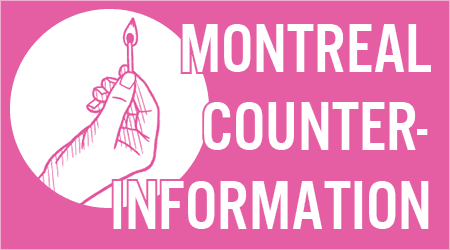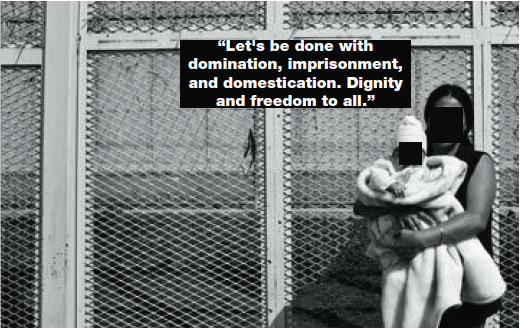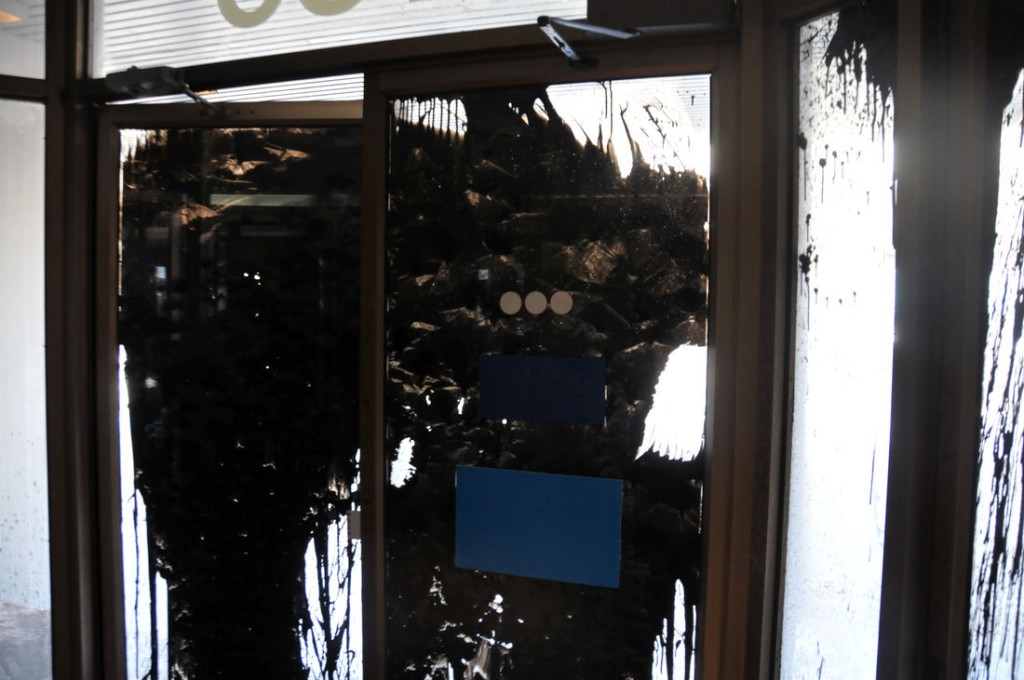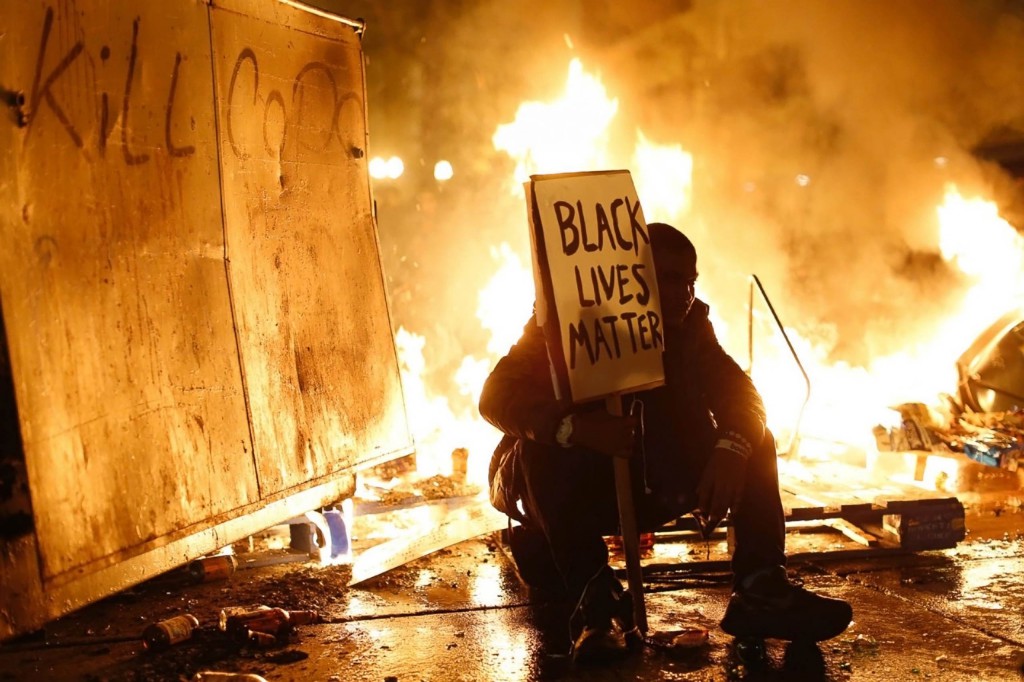From Fire to the Prisons
In February 2012, as the Occupy movement tapered off, a strike broke out against austerity measures in the Québécois higher education system. Prevented from occupying buildings as it had in 2005, the student movement shifted to a strategy of economic disruption: blockading businesses, interrupting conferences and tourist events, and spreading chaos in the streets. At its peak, the resulting unrest surpassed any protest movement in North America for a generation.
The following is an interview with Steve Duhamel aka “Waldo”. A frustrated exstudent, and Quebec-er.
FttP: What was the context for the massive upheavals, mobilizations, and riots that broke out in Montreal in 2012? What took place before these events that helped propel them forward?
Waldo: The original context was an always rising tension between students and the government around the tuition hike issue and a general conception of what public education should be. Kind of boring, but it gets better. We all knew about 2 years in advance that this tuition hike was planned, and in the previous years/months, there were different actions and demonstrations to warn the government that this one will not pass. This government, who had been in power for 9 years, didn’t care much about these protests and arrogantly decided to go forward. They knew that no “political” opposition (as in the official and classical politics) could defeat them, whatever they did, and that they had all the legitimacy to repress any form of “street politics” that wouldn’t recognize their authority.
To get a more general overview of the context, let’s say that what people call society was also becoming more polarized than ever, since both political parties running Québec have a neo-liberal rightwing program and have been alternatively doing some shitty reforms for the past 30 years in order to save their damned economic growth. While the opposition (PQ) was getting its popularity from being the defenders of the French-speakers against the Anglo-Saxon cultural hegemony, they kinda lost all of that slight legitimacy since they’ve been doing the same shit as the federalists from the governing PLQ. This mostly means that social movements progressively took a distance from the Québécois Party (PQ) which itself was born out of (the recuperation of) popular unrests in the 1960’s. This contributed for a long time to prevent any social upheaval, and helped justify a lot of what some folks call “class collaboration” between bosses and the poor. But now, the PQ has a hard time convincing the Québécois folks that the State can really work for them. The last time a tuition hike led to a general student strike was in 1996, while PQist Pauline Marois (the one that was elected in the aftermath of the 2012 movement) was minister of education. Who could believe in her when she came back to oppose Charest?
While PQ usually masks its agenda behind a thin social-democrat veneer, the very “liberal” PLQ openly shits on the poor and doesn’t bother with fake public consultations to sell the province to promoters, mining industries, fracking business, and so on. The Liberal Party of premier Charest came back to power in 2003, and as soon as 2005, a large student strike fought against its plan to cut a huge part of the student scholarship programs (that were set to be replaced by loans, i.e. always more debts). The 2005 strike was really inspiring in its forms of actions, and its spirit was still very present to a lot of the 2012 strikers (way more than what happened in California in 2009, for instance; to a smaller degree, some people were inspired by what was happening then in Chile). Upon entering the movement, large parts of the students already had a mistrust of the reformist federations and even of the more militant ones like ASSÉ. Many people also knew that the strength of the strike came from the uncontrollable multiplication of all kinds of economic and institutional disruptions. And not from the ultra-democratic idea of unity that would decide for any meaningful action and discourse of the movement. That leads to your second question.
FttP: What was the relationship between more insurrectionary anarchist/autonomous groups and the student federations?
Waldo: There wasn’t a single attitude amongst the anarchists in relation to the federations. Where all of them agreed to critique even the ASSÉ (the more militant federation that calls for free education and some kind of self-management) on its reformist demands, a lot of anarchists, even insurrectionary etc, thought it was cool that ASSÉ existed, or at least the CLASSE (which was a coalition of ASSÉ and different independent local unions) because it made it easier to organize a large scale mobilization, to create the event, that could afterward be overwhelmed. On one hand, some anarchists really think the direct-democracy model of the federation’s unionbased assemblies is valid and should only be carried further, that the problem is mostly the lack of consciousness or radical [perspective] of its members, and they think it’s all about radicalizing these spaces, criticizing their discourse on non-violence; a lot of these folks kind of wish there wasn’t a contradiction between the black bloc and the federations. Some others also dream of direct democracy but think we cannot hope anything from the federations except betrayal, and therefore we should build our own spaces and assemblies and organize/ coordinate outside of the “Rand-formula” type mandatory unions we’re stuck with.
Attempts to create such parallel assemblies mostly failed, in 2012, except for a small period between late May and June, when people had these big neighborhood assemblies born out of the massive potsand-pan marches against the “special law.” On the other hand, other anarchist tendencies don’t believe at all in the unions as the basis for the future anarchist society and all of these radical democratic mythologies. While some are more into a nihilistic perspective of the confrontation, against any form of schooling and any possible demands, others think it has never been a question of being for or against the unions, that we should just never believe in it, never think any kind of solution can come from there, or from school in general. It’s rather a question of how to deal with it, how to see the potentiality of it, beyond any moralism or radical purity; how can we compose with the federations, if they are to be there anyway. In any case, federations are to be considered as something alien, that we cannot identify with, but upon which we can intervene, we can meet, make use of, in a way or another.
FttP: Before large scale street demonstrations began, students occupied buildings. How did these actions pave the way for things to come? Were these initial occupations influenced by student occupations in the US or elsewhere?
Waldo: In fact, I wouldn’t say that 2012 was highlighted by any occupations, not being the street itself. Some actions involved blockades of schools or public buildings, disruption of financial centers and such, but from what I know, none of the actual schools in strike were really occupied. On the first day of the strike, people did take over the famous CEGEP du Vieux-Montréal (a pre-university college downtown) whose occupations were once considered the stronghold of the student movement in the previous student strikes. But this time, hundreds of fully-equipped robocops came right away to remind the youth that revolution was no picnic and kicked their asses out of there. About 45 people were jailed and legally banned from the protests for months. The others were dispersed with concussion grenades and pepper-spay. The college was then locked out for the next six months of the strike.
This doesn’t mean people didn’t want to occupy, or that it wasn’t part of our mythology, but the facts are that people didn’t even use many university spaces in the daytime to meet and organize. While in 2005 a lot of people would organize sleepins on different campuses, and cook tons of food to sustain the occupation and make it possible for people to stand together on the frontline, the 2012 strike mostly happened in the street, with people moving all the time, endlessly marching until burning themselves out— when they wouldn’t burn anything else. Yes, occupation of the street, but I would add: mobile occupation, in two different ways. 1.) There were very few attempts to take outdoor public space and keep it, and it was never aimed to last more than a couple hours (I heard about an “occupy” camp outside U.de M., but it didn’t work out). 2.) Outside of that, we could say that it really was the students themselves that were occupied, busy as they were with facebook and twitter and all that shit all the time. No doubt, the strike was really “occupied” by all these new “communication” devices, livestream and everything…
FttP: Anarchists and insurrectionary autonomists promoted their ideas through publications and saw many students join in their ranks during the yearly March 15th protests against police brutality. Can you talk about how insurrectionary antiauthoritian ideas were spread, and took on new currency during this time of struggle? For instance, anarchists and insurrectionists have talked a lot about how the use of masks spread through the long process of militants doing it during demos/riots, and also explained why they were doing it in conversations and flyers.
Waldo: I’d say that, as opposed to previous movements, this strike was amazingly rich with radical literature, specifically in the couple months leading to it, but then almost nothing consistent was really produced during the movement. It was as if every political tendency, anarchist circle or whatever (often born out of the 2005 movement), had their own publication ready before the strike in order to set things clear, to share what they had learned from the past struggles and go forward with a couple propositions.
Once the strike was launched, very few texts were circulating outside worthless opinions on the internet. Still, from what I recall, at one point (after a demo where some excited douche bags had beaten the shit out of a couple of black clad kids) we saw at least half a dozen different flyers criticizing the authoritarian pacifist ideology that undermined solidarity amongst demonstrators. As for the masks, more than any literature, I’d say it’s the practice itself of wearing them, and the cops practice of systematically filming protesters, that led to widespread use of masks. The same for the March 15th demo, I think it got bigger that year because of the context, where a lot of people were experiencing daily repression by angry cops and a guy lost an eye like 3 days before the demo. Even the mayor advertised for the demo on TV, telling people not to go!
FttP: What led to the student movement spilling out in the wider social terrain?
Waldo: To make it short, I’d say that first, there was already popular support of the students, that was made visible by the widespread use of the “red square” pin by millions of people and also by the 500,000 people marches like the one on March 26th, where the majority wasn’t even student, and showed the growing unpopularity of the Charest government. People literally had enough, and students were seen as the only sector of society that could massively mobilize, since all workplace unions and work laws make it almost impossible to build a real massive and coordinated union-based general strike.
A lot of people that weren’t students didn’t want to get too into the movement since they thought it wasn’t theirs, so they remained in a solidarity position, but what made a clear difference was the insolent and arrogant attitude of prime minister Charest, his constant provocations and specifically the declaration of a “special law,” in the night between the 17th and 18th of May, that made demonstrations illegal and added expensive fines for any acts of striking, blockading, occupation and so on. This law also locked out students from their schools until the end of summer to allow businesses to hire summer jobbers, and incidentally produce a demobilizing effect, since there was no more university to block. Maybe worst of all, the law came with the announcement of anticipated elections in the first week of September. The first weeks following the declaration of the dirty law saw an unprecedented social reaction: daily demonstrations in different towns and neighborhoods, with thousands of people defying the State; you would see your unknown neighbors smiling at you, chanting along the common motto: “The special law, we don’t give a damn!”
But then, after I’d say the week of the Grand Prix, (around June 10th), people slowly started to take a break, go on vacation to rest until, we all thought, the real war was to begin. The government forced schools to reopen around August 13th, starting with the CEGEPs, but even with all the motivation of the most determined strikers, a lot of assemblies finally and sadly voted with a slight majority against the continuation of the strike. Many students either got scared to lose their semester, and others thought it was pointless to remain on strike while there was going to be an election soon which meant there was no government to deal with yet. That fucked us real bad. A lot of leftists started to say we should spend our energies mobilizing for the elections, so that Charest would be kicked out. That was also a big reason why popular support got weaker; a lot of people thought we should vote and drop our bricks and stones.
Then, what we saw was no surprise. PQ got elected – with only a minority of the assembly – that silly Marois became premier and she did proclaim the abrogation of the special law and temporarily canceled the tuition hike. But that was just bullshit, it took a couple weeks before she said we would have to negotiate some kind of tuition hike sometime soon and she didn’t revoke all the municipal laws that were declared during the movement— e.g. making it criminal to wear masks and to march without permission from the cops. The most ridiculous part of this history is that Marois, who survived an assassination attempt by an Anglo redneck freak gone mad the night she got elected, didn’t politically survive the reactionary populist move she made the year after, aimed at imposing her “chart of values,” supposedly to protect the Québécois “secular” culture against foreign influences. So multi-culturalist PLQ came back to power less than a year and a half after the end of the strike that our funny syndicalist friends claimed was victorious!
FttP: During Occupy in the US, we largely saw that when the state attacked, the movement often quickly folded. Whereas in Montreal, we saw people go on the offensive. Was this because people found that they could win street battles? As in the famous scenes of people making the pigs turn tail and flee?
Waldo: Québécois or Montrealers aren’t more courageous, or even more anarchist than anywhere else. The end of the movement has proven that. Only, there is the specificity of the situation: an overly and counter-productively arrogant government in front of a massive and determined movement that leaves a lot of autonomy to its base, all of that in a relatively tight-knit society where anything echoes really fast. This might be an explanation as to why the Anglo campuses weren’t as mobilized, even if they were, more than ever before. People were pumped by Charest and the cops, who underestimated the determination of the students and their popular support (politics is often a gamble). This easily led to an escalation, were people saw they were strong and felt it was OK to kick a few cops asses.
FttP: Can you talk about how resistance to Plan Nord brought anarchist, student, and indigenous struggles together? Can you explain what Plan Nord is and why people were interested in destroying it?
Waldo: Plan Nord is just the name for a new phase of in-your-face colonization of the North-Eastern part of the continent, that is claimed by the colonial states of Québec and Canada. It’s hard to tell how seriously the average students marching against Charest took Plan Nord, or how many of those same students stormed the Plan Nord convention because of anti-colonial and ecologist convictions or whatever. Of course, there is an official sympathy amongst the movement toward these struggles, but I think the disruption of the congress and the riot that occurred was made possible because everybody knew it would make Charest angry, since Plan Nord was like his “little thing” he was so proud of, and that every decent person thinks it’s robbery. I still think that it’s in these kind of social upheavals that struggles that appear to be different show how much they are related, and impact one another. It’s still because of the strike they were involved in that many people got interested in native peoples’ struggles, and specifically in the fight against Plan Nord.
FttP: When the government outlawed protests of more than 50 people, the movement grew and more people joined. Community popular assemblies sprung up. Can you talk about these gatherings? How widespread were they?
Waldo: I’ve talked about that earlier, but let’s say theses assemblies were spontaneously created in at least a dozen neighborhoods of Montreal, and for about a month, they would meet around once a week, in a park or a community space, and, depending on the neighborhood, there were between 30 and 300 people. This number slowly went down as the summer came, and also, we must admit, as they got formalized and semi-institutionalized. What was interesting is how much different the organizational issue differed from one neighborhood to another. I mean, some were super obsessed with structures and sophisticated mechanisms that are supposed to help prevent domination and oppressive patterns in groups, others were more relaxed, but weren’t necessarily more effective, some would focus more on community issues while some remained in a position of solidarity with the student movement.
But yeah, too little too late, I suppose. I think it would have been really different if theses assemblies would have started earlier in the movement, and more than everything (and more realistically), if the strike had continued in September. It would have totally changed the quality of the movement. I mean, it could have opened a place where the union assemblies wouldn’t be the main space to discuss and organize the struggle, and it could have spread more easily to non-student issues and places. The elections really killed all these potentialities.
FttP: In an interview with Submedia, one anarchist participant talked about the use of projectiles in creating/defending space from the police, and the ability that physical attack gave people in expanding the conflictual nature of the strike. Can you speak to this?
Waldo: I don’t know what to say about that. Is it the expansion of the conflict that makes it possible to attack, or the opposite? Is it going both ways? The ability to attack didn’t always mean ability to get away with it. A lot of people got badly wounded with nothing much to show for it. There has been a lot of talking amongst anarchists in the last 15 years about “diversity of tactics,” but very few people thought about diversity of strategies, leaving this problem to union bosses, Leninists and social-democrats. And to the police, and the capitalists. Let’s say there is a confrontation. What is the space that we create, that we defend, while doing what we do? It’s not always quite clear. I’m totally not against all kinds of direct action, but I think sometimes there is a dangerous belief that direct action is good in itself, while it can often make us weaker. Black bloc was once a tactic, nowadays it often looks like an ideology, an identity. We should never denounce comrades who engage in this type of action and we should be ready, as much as we can, to protect them against cops and violent pacifists, but I think “attacking” can never become a strategy in itself; can never replace the need for a strategy. This said, the question should never be whether we attack or not, but rather how do we do it, when and where. What makes it possible to attack in a way that gives us more strength instead of isolating us? These are serious questions.
We should not neglect the anxiety that direct actions create amongst the activists themselves and their friends, when it’s done without thinking, because it’s seen as the radical good. It’s not just attacking that makes people able and willing to attack, that expands the conflictuality of a movement, it’s the strength that we build through all kinds of links, shared experiences, shared spaces and materials, tools and stories, and languages, shared love and thrust, etc. All kinds of things also come into play when it’s time to fight, which constitutes our strength, and that we cannot put at risk for a matter of purity or for a romantic belief in the power of action. An action is not good because it’s against the right enemy nor because it has good intentions: it’s only good when it makes us stronger. To the moralism of pathological pacifists, we should not impose another kind of moralism.
FttP: What does the future hold for those in Montreal? Will we see continued unrest at the universities and beyond?
Waldo: Everything is possible. The tuition hike is showing up again and the federations are already mobilized. The experience of 2012 is still fresh and a lot of people don’t want to lose what has been learned and built. The repressive machine is better prepared, and more determined than ever, it’s hard to say if people are too. There is already some organizing being done outside the unions, and the electoral threat should not be part of the play this time. It’s hard to tell if there will be as much popular support, but there are apparently more chances that we will see different unions from the public sector go on strike in the next months (even the cops are currently protesting against the Québec government). I still think we should not hope for anything and just do what we have to do. Things always happen anyway, it’s just a matter of staying ready.
More on the 2012 Student Strike:
www.crimethinc.com/texts/recent features/montreal1.php
In French:
faire-greve.blogspot.ca

















